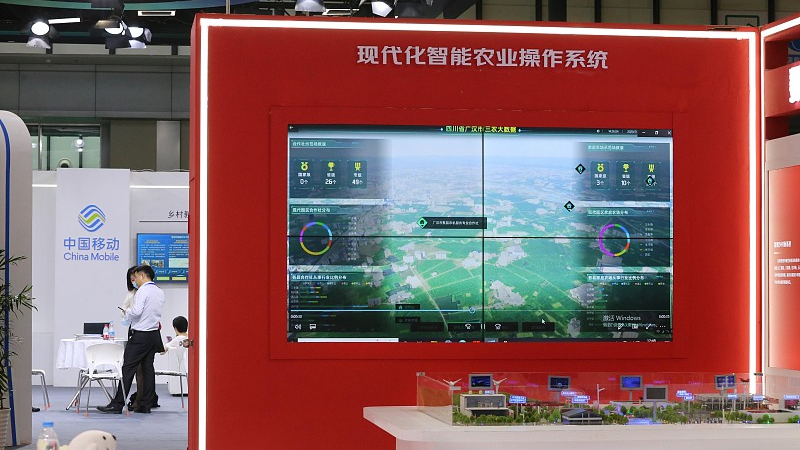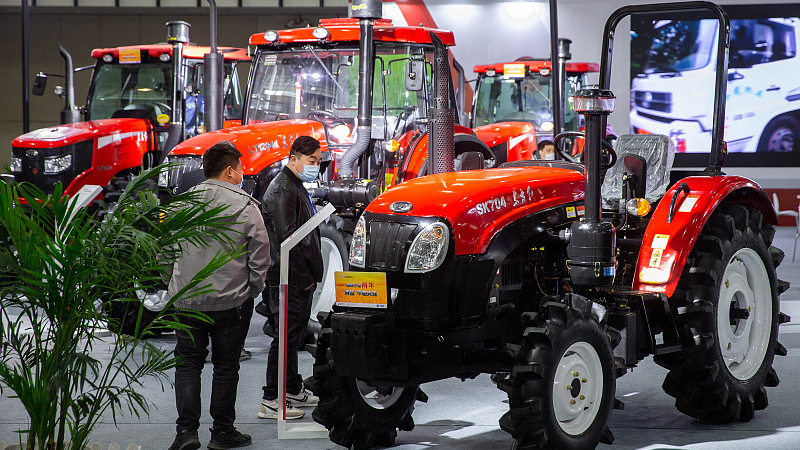
The intelligent agricultural operating system displayed at the 2022 China International Intelligent Agriculture Expo, Nanjing, east China's Jiangsu Province, July 6, 2022. /CFP
The intelligent agricultural operating system displayed at the 2022 China International Intelligent Agriculture Expo, Nanjing, east China's Jiangsu Province, July 6, 2022. /CFP
Editor's note: Alexander Ayertey Odonkor is an economic consultant, chartered financial analyst and chartered economist with an in-depth understanding of the economic landscape of countries in Asia and Africa. The article reflects the author's opinions and not necessarily the views of CGTN.
On August 16, 2022, the Chinese Academy of Agricultural Sciences (CAAS) launched a campaign to enhance scientific and technological innovations in agricultural machinery and equipment nationwide. China's agriculture, one of the worlds ancient civilizations, has undergone many transformations – from the use of crude tools for farming, to integrating advanced machinery and technologies in recent years.
The structural changes remain crucial for boosting agricultural productivity and strengthening food security in the world's most populous nation. In fact, with less than 10 percent of the world's total arable land, it seemed impossible for China to feed one-fifth of the world's entire population. Yet, the country's structural agricultural transformations, along with other related industries, have all been underpinned by the country's amazing scientific and technological innovations.
According to the Food and Agriculture Organization of the United Nations, China is the world's leading producer of vegetables, fruits, poultry, fishery products, cotton, eggs, cereals, and meat. Meanwhile, China's policymakers and relevant stakeholders remain committed to tapping into additional resources to optimize sustainable agricultural productivity that in recent years, have been supported by the use of newfangled digital technologies – pushing for smart agriculture, while incorporating advanced information and communications technology (ICT) infrastructure into agriculture – leveraging the internet of things (IoT), artificial intelligence (AI), robots and drones to strengthen rural development.
Presently, farmers in Chailixi village in Tengzhou city of East China's Shandong Province, the country's largest producer of vegetables and grains, known in the past to rely on simple tools such as hoes for farming have switched to smart agriculture – with only a smartphone, local farmers can monitor air temperature and carbon dioxide levels in greenhouses in real-time, and remotely contact experts for guidance on the best agricultural practices to adopt for the planting season, which can upgrade agricultural production efficiency and revitalizing the nation's rural development.

Visitors at the 11th Jiangsu International Agricultural Machinery Fair, Nanjing, April 14, 2021. /CFP
Visitors at the 11th Jiangsu International Agricultural Machinery Fair, Nanjing, April 14, 2021. /CFP
Compared to a few years ago, Chinese farmers are relying much more on drones for monitoring, spraying and risk mitigation on their farmlands. The availability of these digital technologies has better positioned farmers to benefit more from smart agriculture. The Chinese government's investment in domestic ICT infrastructure development has yielded terrific results, coming alongside with tremendous government support for smart agriculture advances.
As of December 2021, the total number of internet users in China had reached 1.03 billion, up by 42.96 million from December 2020, representing an internet penetration rate of 73 percent – which indicates an rising internet penetration rate in both rural and urban areas. With the country's current massive internet penetration rate, which is highly likely to grow further in the years ahead, the entire agricultural value chain is becoming more tightly connected from production to marketing – a digital transformation that is reducing agricultural production costs, upgrading efficiency and creating new job opportunities for local communities in the rural areas.
Farmers can now access ready markets for agricultural products via e-commerce platforms, an avenue that was not available to them just a few years ago. According to recent data released by JD.com, China's largest online retailer, show that since the start of Spring on February 4, 2022, the online transaction volume of the company's agricultural products, plants, and other green consumption has increased by over 40 percent year-on-year (YoY) and the turnover of fertilizers and gardening has also increased by 317 percent and 247 percent (YoY), respectively.
In rural areas, online consumption of agricultural products has also soared – prior to the spring equinox in 2022 the transaction value of domestic agricultural technology services had grown by over 10 times (YoY), in county-level rural areas, agricultural technology services had increased by 20 percent, and the share of transaction volume rose from 62 percent to 82 percent.
An incredible growth pattern that elucidates why the National Plan for Agricultural and Rural Informatization for the 14th Five-Year Plan (2021-2026) issued by the Ministry of Agriculture and Rural Affairs on March 9, 2022 proposes smart agriculture as the main direction for high-quality development of agricultural and rural informatization. And while the plan proposes by 2025 for smart agriculture to achieve an ambitious new milestone – the informatization rate of agricultural production will reach 27 percent and annual online retail sales of agricultural products will exceed 800 billion yuan ($125.8 billion). But there's still a lot of work to be done in order to achieve this goal.
To bridge the gap and sustain high-quality growth that is essential for sustainable agriculture, it's imperative for policymakers and relevant stakeholders to bring onboard small and medium-sized enterprises (SMEs) as they represent the largest share of all businesses in the country – strengthening the capacities of these SMEs, particularly the high-growth enterprises to support research and development for smart agriculture, will boost the production of innovative digital technologies for smart agriculture in China.
(If you want to contribute and have specific expertise, please contact us at opinions@cgtn.com. Follow @thouse_opinions on Twitter to discover the latest commentaries in the CGTN Opinion Section.)

